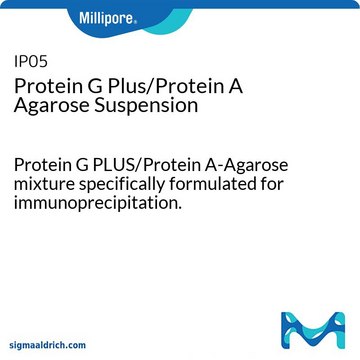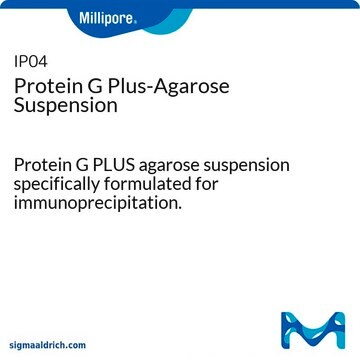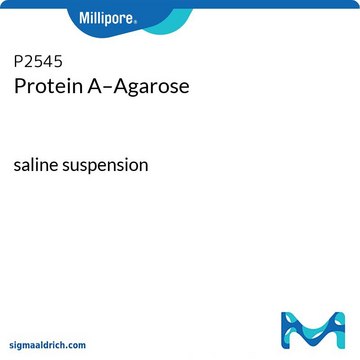おすすめの製品
フォーム
slurry (Liquid)
含みます
≤0.1% sodium azide as preservative
メーカー/製品名
Calbiochem®
保管条件
do not freeze
テクニック
protein purification: suitable
適合性
suitable for microbiology
輸送温度
wet ice
保管温度
2-8°C
詳細
A mixture of Protein G PLUS and Protein A covalently conjugated to agarose. Useful for purification of IgG from biological fluids.
Designed for immunoglobulin purification at low pressure. Product size refers to the volume of packed beads.
アプリケーション
Antibody Purification
警告
Toxicity: Standard Handling (A)
物理的形状
50% suspension in PBS.
その他情報
Note: the product size refers to the volume of packed beads. This product can be used directly with serum, plasma, tissue culture media, ascites, or other biological fluids, but if sufficient quantities of starting material are available we recommend an initial clean up step. The column life will be greatly extended if aggregated proteins and lipids are removed from the immunoglobulin in the clean up step. Use 5-10 ml of packed beads per ml serum.
Recommended Protocol for IgG Purification
Buffers
All concentrations stated are for working solutions, not the 10X concentrates. Caution: sodium azide is poison.
• Binding/Washing Buffer: 100 mM sodium phosphate pH 7.0, 150 mM sodium chloride, 5 mM sodium EDTA, 0.01% sodium azide.
• Elution Buffer A (see Note section): 500 mM ammonium acetate pH 3.0, 0.01% sodium azide.
• Elution Buffer B: 10 mM glycine/HCl pH 3.0, and 0.01% sodium azide.
• Neutralization Buffer: 500 mM Tris Base, 0.01% sodium azide.
• Storage Buffer: 100 mM sodium phosphate, pH 7.0, 0.01% sodium azide.
Protocol
A. Clean Up and Concentration
Ascites and serum should be clotted at room temperature, refrigerated at 4°C overnight (to allow the clot to shrink and lipids to separate), and centrifuged multiple times to remove all clotted protein and lipid. Remove the lipid from the top of the centrifuge tube with a glass rod or small wooden stick. Tissue culture media should be centrifuged or filtered to remove aggregates.
IgG can be concentrated and partially purified by use of an ammonium sulfate precipitation step. Add ammonium sulfate to 50% saturation (313 g per L) with stirring and check the pH adjusting to 7.0 by addition of 1 M HCl or NaOH. Centrifuge to collect precipitated immunoglobulin, dissolve in binding buffer and dialyze against the same buffer.
B. Purification
1. Pack a column with the Agarose Conjugate.
2. Wash with about 20 column volumes Washing/Binding Buffer until pH of eluate is 7.0.
3. If IgG has not been previously dialyzed against binding buffers dilute or dialyze IgG-containing sample into the Washing/Binding Buffer (pH 6.5-7.5).
4. Load sample onto column.
5. Wash with Washing/Binding Buffer until the absorbance of the eluate at 280 nm approaches background level.
6. Wash with Elution Buffer A to elute IgG, and collect fractions until A280 returns to background levels.
7. Wash with Elution Buffer B, and collect fractions until A280 returns to background. Most IgG should elute with buffer A.
8. Neutralize eluted IgG fractions by addition of an equal volume of neutralization buffer and check the pH with pH paper. For best results, neutralize eluate promptly.
9. To re-use the column immediately, repeat procedure from Step 2.
10. To prepare the column for storage, wash column with 5 column volumes of Elution Buffer B.
11. To store column wash with 30 column volumes storage buffer; then seal column outlets and store in refrigerator.
12. Quantitate the purified IgG using the formula:
Absorbance at 280 nm/1.4 = Concentration (mg/ml).
To make Elution Buffer A, start with acetic acid and adjust the pH to 3.0 with ammonium hydroxide.
Recommended Protocol for IgG Purification
Buffers
All concentrations stated are for working solutions, not the 10X concentrates. Caution: sodium azide is poison.
• Binding/Washing Buffer: 100 mM sodium phosphate pH 7.0, 150 mM sodium chloride, 5 mM sodium EDTA, 0.01% sodium azide.
• Elution Buffer A (see Note section): 500 mM ammonium acetate pH 3.0, 0.01% sodium azide.
• Elution Buffer B: 10 mM glycine/HCl pH 3.0, and 0.01% sodium azide.
• Neutralization Buffer: 500 mM Tris Base, 0.01% sodium azide.
• Storage Buffer: 100 mM sodium phosphate, pH 7.0, 0.01% sodium azide.
Protocol
A. Clean Up and Concentration
Ascites and serum should be clotted at room temperature, refrigerated at 4°C overnight (to allow the clot to shrink and lipids to separate), and centrifuged multiple times to remove all clotted protein and lipid. Remove the lipid from the top of the centrifuge tube with a glass rod or small wooden stick. Tissue culture media should be centrifuged or filtered to remove aggregates.
IgG can be concentrated and partially purified by use of an ammonium sulfate precipitation step. Add ammonium sulfate to 50% saturation (313 g per L) with stirring and check the pH adjusting to 7.0 by addition of 1 M HCl or NaOH. Centrifuge to collect precipitated immunoglobulin, dissolve in binding buffer and dialyze against the same buffer.
B. Purification
1. Pack a column with the Agarose Conjugate.
2. Wash with about 20 column volumes Washing/Binding Buffer until pH of eluate is 7.0.
3. If IgG has not been previously dialyzed against binding buffers dilute or dialyze IgG-containing sample into the Washing/Binding Buffer (pH 6.5-7.5).
4. Load sample onto column.
5. Wash with Washing/Binding Buffer until the absorbance of the eluate at 280 nm approaches background level.
6. Wash with Elution Buffer A to elute IgG, and collect fractions until A280 returns to background levels.
7. Wash with Elution Buffer B, and collect fractions until A280 returns to background. Most IgG should elute with buffer A.
8. Neutralize eluted IgG fractions by addition of an equal volume of neutralization buffer and check the pH with pH paper. For best results, neutralize eluate promptly.
9. To re-use the column immediately, repeat procedure from Step 2.
10. To prepare the column for storage, wash column with 5 column volumes of Elution Buffer B.
11. To store column wash with 30 column volumes storage buffer; then seal column outlets and store in refrigerator.
12. Quantitate the purified IgG using the formula:
Absorbance at 280 nm/1.4 = Concentration (mg/ml).
To make Elution Buffer A, start with acetic acid and adjust the pH to 3.0 with ammonium hydroxide.
法的情報
CALBIOCHEM is a registered trademark of Merck KGaA, Darmstadt, Germany
保管分類コード
11 - Combustible Solids
WGK
WGK 1
引火点(°F)
Not applicable
引火点(℃)
Not applicable
適用法令
試験研究用途を考慮した関連法令を主に挙げております。化学物質以外については、一部の情報のみ提供しています。 製品を安全かつ合法的に使用することは、使用者の義務です。最新情報により修正される場合があります。WEBの反映には時間を要することがあるため、適宜SDSをご参照ください。
Jan Code
IP10-10ML:
試験成績書(COA)
製品のロット番号・バッチ番号を入力して、試験成績書(COA) を検索できます。ロット番号・バッチ番号は、製品ラベルに「Lot」または「Batch」に続いて記載されています。
この製品を見ている人はこちらもチェック
Paul F Bradfield et al.
Arthritis and rheumatism, 48(9), 2472-2482 (2003-09-18)
A characteristic feature of the inflammatory infiltrate in rheumatoid arthritis is the segregation of CD4 and CD8 T lymphocyte subsets into distinct microdomains within the inflamed synovium. The aim of this study was to test the hypothesis that chemokines in
Michelle A Schultz et al.
PloS one, 9(1), e87204-e87204 (2014-01-28)
Despite androgen deprivation therapy (ADT), persistent androgen receptor (AR) signaling enables outgrowth of castration resistant prostate cancer (CRPC). In prostate cancer (PCa) cells, ADT may enhance AR activity through induction of oxidative stress. Herein, we investigated the roles of Nrf1
Meihan Liu et al.
International journal of biological sciences, 15(3), 617-627 (2019-02-13)
Metformin, a common therapeutics for type 2 diabetics, was recently demonstrated to possess antitumor activity in various cancer types. However, its therapy effect in renal cell carcinoma (RCC) still remains controversial. In this study, we found that metformin treatment in
Yuge Jiang et al.
Cell death discovery, 8(1), 404-404 (2022-10-02)
Sevoflurane anesthesia is reported to repress neurogenesis of neural stem cells (NSCs), thereby affecting the brain development, but the underlying mechanism of sevoflurane on the proliferation of NSCs remains unclear. Thus, this study aims to discern the relationship between sevoflurane
Xu Liu et al.
Nature communications, 7, 12768-12768 (2016-09-15)
The antagonistic crosstalk between gibberellic acid (GA) and abscisic acid (ABA) plays a pivotal role in the modulation of seed germination. However, the molecular mechanism of such phytohormone interaction remains largely elusive. Here we show that three Arabidopsis NUCLEAR FACTOR-Y
ライフサイエンス、有機合成、材料科学、クロマトグラフィー、分析など、あらゆる分野の研究に経験のあるメンバーがおります。.
製品に関するお問い合わせはこちら(テクニカルサービス)









